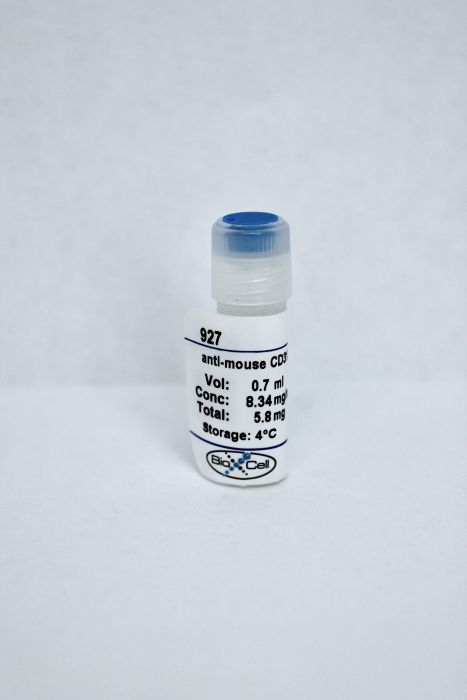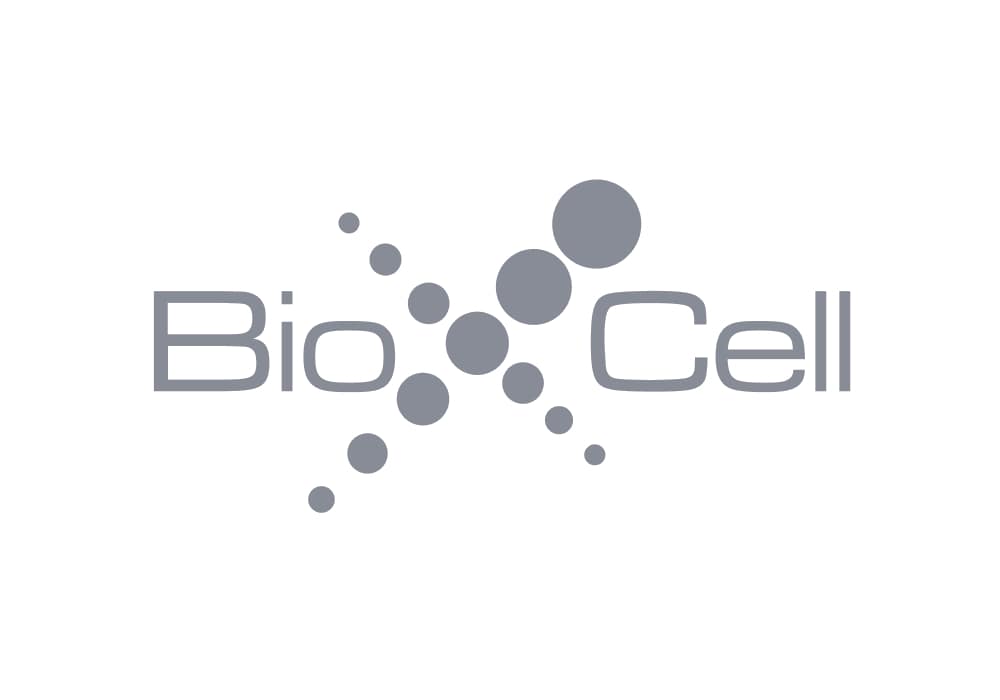InVivoMAb anti-mouse CD317 (BST2, PDCA-1)
Product Details
The 927 monoclonal antibody reacts with mouse CD317 also known as BST2 and PDCA-1, a 29-33 kDa type II transmembrane glycoprotein. CD317 is expressed exclusively by plasmacytoid dendritic cells and serves as a marker for these cells. CD317 is also sometimes expressed by some tumor cells, including multiple myeloma, renal cell carcinoma, and melanoma cells. The 927 antibody is a useful tool to specifically deplete plasmacytoid dendritic cells when administered in vivo.Specifications
| Isotype | Rat IgG2b, κ |
|---|---|
| Recommended Isotype Control(s) | InVivoMAb rat IgG2b isotype control, anti-keyhole limpet hemocyanin |
| Recommended Dilution Buffer | InVivoPure pH 7.0 Dilution Buffer |
| Immunogen | Mouse type I IFN-producing cells |
| Reported Applications |
in vivo pDC depletion Immunofluorescence Flow cytometry |
| Formulation |
PBS, pH 7.0 Contains no stabilizers or preservatives |
| Endotoxin |
<2EU/mg (<0.002EU/μg) Determined by LAL gel clotting assay |
| Sterility | 0.2 μM filtered |
| Production | Purified from tissue culture supernatant in an animal free facility |
| Purification | Protein G |
| RRID | AB_2736991 |
| Molecular Weight | 150 kDa |
| Storage | The antibody solution should be stored at the stock concentration at 4°C. Do not freeze. |
Recommended Products
Flow Cytometry, in vivo pDC depletion
Bone marrow stromal cell antigen 2 is a specific marker of type I IFN-producing cells in the naive mouse, but a promiscuous cell surface antigen following IFN stimulation PubMed
Type I IFN-producing cells (IPC) are sentinels of viral infections. Identification and functional characterization of these cells have been difficult because of their small numbers in blood and tissues and their complex cell surface phenotype. To overcome this problem in mice, mAbs recognizing IPC-specific cell surface molecules have been generated. In this study, we report the identification of new Abs specific for mouse IPC, which recognize the bone marrow stromal cell Ag 2 (BST2). Interestingly, previously reported IPC-specific Abs 120G8 and plasmacytoid dendritic cell Ag-1 also recognize BST2. BST2 is predominantly specific for mouse IPC in naive mice, but is up-regulated on most cell types following stimulation with type I IFNs and IFN-gamma. The activation-induced promiscuous expression of BST2 described in this study has important implications for the use of anti-BST2 Abs in identification and depletion of IPC. Finally, we show that BST2 resides within an intracellular compartment corresponding to the Golgi apparatus, and may be involved in trafficking secreted cytokines in IPC.
in vivo pDC depletion
Plasmacytoid dendritic cell-derived type I interferon is crucial for the adjuvant activity of Toll-like receptor 7 agonists PubMed
There is a high demand for the development of adjuvants that induce cytotoxic T lymphocytes, which are crucial for the elimination of intracellular pathogens and tumor cells. Toll-like receptor (TLR) agonists are prime candidates to fulfill this role because they induce innate immune activation and promote adaptive immune responses. The successful application of the TLR7 agonist R837 for treatment of basal cell carcinoma shows the potential for exploiting this pathway in tumor immunotherapy. Imidazoquinolines like R837 and stimulatory ssRNA oligonucleotides both trigger TLR7-mediated immune activation, but little is known about their comparative ability to promote immunity induction. We investigated differences in innate immune activation and adjuvant activity between the imidazoquinoline R848 and the ssRNA TLR7 agonist polyUs21. In contrast to R848, polyUs21 induced detectable levels of intracellular interferon-alpha (IFN-alpha) in plasmacytoid dendritic cells (PDCs). In immunization studies, only polyUs21 led to robust priming of type 1 T helper cells and cytotoxic T lymphocytes, and it was more efficient in inducing antitumor immunity than R848. Notably, exogenous IFN-alpha augmented the adjuvant activity of R848, whereas depletion of PDC abrogated the adjuvanticity of polyUs21. This study, therefore, identifies sufficient IFN-alpha production by PDC as an important determinant of vaccine efficacy.
in vivo pDC depletion
Plasmacytoid dendritic cells modulate nonprotective T-cell responses to genital infection by Chlamydia muridarum PubMed
Given their immune-modulating capacity, regulatory T cells (Treg) cells may be important players in the induction of the protective T-cell response (Th1) to genital chlamydial infection. Recent work has demonstrated that plasmacytoid dendritic cells (pDC) respond to genital chlamydial infection, and that pDC may be uniquely positioned for the induction of Treg cells during this infection. Here, we present the first data demonstrating that Treg influx into the draining lymph node and the site of infection during genital chlamydial infection. We found that pDC depletion altered the numbers of Treg and nonprotective inflammatory cells [interferongamma-(IFNgamma)-producing CD8+ T and IFNgamma-producing natural killer T cells] in the spleens of mice genitally infected with Chlamydia muridarum. Furthermore, pDC depletion did not alter Th1 cell numbers, indicating that pDC modulate cells that could inhibit and promote nonprotective inflammation during genital chlamydial infection. Finally, we demonstrate that depletion of pDC results in less severe dilation and collagen deposition in the oviduct following resolution of infection, implicating pDC activity in the formation of sequelae following genital C. muridarum infection.
Immunofluorescence
In vivo biotinylation of the vasculature in B-cell lymphoma identifies BST-2 as a target for antibody-based therapy PubMed
The discovery of accessible markers of lymphoma may facilitate the development of antibody-based therapeutic strategies. Here, we describe the results of a chemical proteomic study, based on the in vivo biotinylation of vascular proteins in lymphoma-bearing mice followed by mass spectrometric and bioinformatic analysis, to discover proteins expressed at the tissue-blood border of disseminated B-cell lymphoma. From a list of 58 proteins, which were more than 10-fold up-regulated in nodal and extranodal lymphoma lesions compared with their levels in the corresponding normal host organs, we validated BST-2 as a novel vascular marker of B-cell lymphoma, using immunochemical techniques and in vivo biodistribution studies. Furthermore, targeting BST-2 with 2 independent monoclonal antibodies delayed lymphoma growth in a syngeneic mouse model of the disease. The results of this study delineate a strategy for the treatment of systemic B-cell lymphoma in humans and suggest that anti-BST-2 antibodies may facilitate pharmacodelivery approaches that target the tumor-stroma interface.
Flow Cytometry
Activation of Plasmacytoid Dendritic Cells in Colon-Draining Lymph Nodes during Citrobacter rodentium Infection Involves Pathogen-Sensing and Inflammatory Pathways Distinct from Conventional Dendritic Cells PubMed
Dendritic cells (DCs) bear the main responsibility for initiation of adaptive immune responses necessary for antimicrobial immunity. In the small intestine, afferent lymphatics convey Ags and microbial signals to mesenteric lymph nodes (LNs) to induce adaptive immune responses against microbes and food Ags derived from the small intestine. Whether the large intestine is covered by the same lymphatic system or represents its own lymphoid compartment has not been studied until very recently. We identified three small mesenteric LNs, distinct from small intestinal LNs, which drain lymph specifically from the colon, and studied DC responses to the attaching and effacing pathogen Citrobacter rodentium in these. Transcriptional profiling of conventional (CD11c(high)CD103(high)) DC and plasmacytoid (plasmacytoid DC Ag-1(high)B220(+)CD11c(int)) DC (pDC) populations during steady-state conditions revealed activity of distinct sets of genes in these two DC subsets, both in small intestinal and colon-draining LNs. C. rodentium activated DC especially in colon-draining LNs, and gene expression changed in pDC more profoundly than in conventional DC. Among the genes most upregulated in pDC were C-type lectin receptor CLEC4E, IL-1Rs (IL-1R1 and -2), proinflammatory cytokines (IL-1a and IL-6), and TLR6. Our results indicate that colon immune surveillance is distinct from that of the small intestine in terms of draining LNs, and identify pDC as active sentinels of colonic inflammation and/or microbial dysbiosis.
in vivo pDC depletion
Murine Cytomegalovirus Disrupts Splenic Dendritic Cell Subsets via Type I Interferon-Dependent and -Independent Mechanisms PubMed
Dendritic cells (DC) are well-known modulators of immunity. This heterogeneous population is composed of defined subsets that exhibit functional specialization and are critical in initiating responses to pathogens. As such, many infectious agents employ strategies to disrupt DC functioning in attempts to evade the immune system. In some instances, this manifests as an outright loss of these cells. Previous work has suggested that, in the absence of an efficient natural killer (NK) cell response, murine cytomegalovirus (MCMV) induces large amounts of interferon (IFN)-I. This heightened IFN-I response is thought to contribute to conventional DC (cDC) loss and delayed development of T cell immunity. However, the precise role of IFN-I in such cDC loss remains unclear. We investigated the effects of licensed NK cells and IFN-I signaling on splenic cDC subsets during MCMV infection and found that a licensed NK cell response partially protects cDC numbers, but does not prevent increases in serum IFN-I. This suggested that high residual IFN-I could contribute to cDC loss. Therefore, we used multiple strategies to modulate IFN-I signaling during MCMV infection including plasmacytoid DC depletion, IFN-I receptor (IFNAR) blockade, and genetic ablation of IFNAR expression. Interestingly, restriction of IFN-I signals did not substantially preserve either CD8(+) or CD4(+) DC total numbers, but resulted in significant retention and/or accumulation of the splenic CD8(-) CD4(-) [double negative (DN)] subset. However, the DN DC effect manifested in a DC-extrinsic manner since IFNAR-deficient cells were not preferentially retained over their IFNAR wild-type counterparts in a mixed-chimera setting. Our results show that IFN-I signaling is not responsible for overt cDC toxicity in the setting of acute MCMV infection and emphasize that additional mechanisms contribute to DC loss and require exploration.
in vivo pDC depletion
Microbiota-Driven Tonic Interferon Signals in Lung Stromal Cells Protect from Influenza Virus Infection PubMed
Type I interferon (IFNα/β) pathways are fine-tuned to elicit antiviral protection while minimizing immunopathology; however, the initiating stimuli, target tissues, and underlying mechanisms are unclear. Using models of physiological and dysregulated IFNα/β receptor (IFNAR1) surface expression, we show here that IFNAR1-dependent signals set the steady-state IFN signature in both hematopoietic and stromal cells. Increased IFNAR1 levels promote a lung environment refractory to early influenza virus replication by elevating the baseline interferon signature. Commensal microbiota drive the IFN signature specifically in lung stroma, as shown by antibiotic treatment and fecal transplantation. Bone marrow chimera experiments identify lung stromal cells as crucially important for early antiviral immunity and stroma-immune cell interaction for late antiviral resistance. We propose that the microbiota-driven interferon signature in lung epithelia impedes early virus replication and that IFNAR1 surface levels fine-tune this signature. Our findings highlight the interplay between bacterial and viral exposure, with important implications for antibiotic use.


